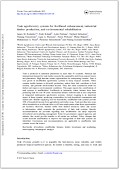| Journal Article |
 |
|
| Article Title | Teak agroforestry systems for livelihood enhancement, industrial timber production, and environmental rehabilitation | | Author | James M Roshetko, Dede Rohadi, Aulia Perdana, Gerhard Sabastian, Nunung Nuryartono, Agus Astho Pramono, Nurin Widyani, Philip Manalu, Muhammad Anies Fauzi, Purnomo Sumardamto and Nuning Kusumowardhani | | Year | 2013 | | Journal Title | Forests, Trees and Livelihoods | | Institution | Taylor & Francis | | Pages | 1-16 | | Call Number | JA0496-13 | | Keywords | silviculture; smallholder farmers; timber investment and marketing; intercropping; tumpangsari; taungya |
|
| Abstract: |
| Teak is produced in industrial plantations in more than 43 countries. National and
international demand for teak timber exceeds the sustainable yield from natural forests
and plantations. High demand creates opportunities for enterprising farmers. Teak is
now grown in smallholder agroforestry systems in many tropical countries. These
systems enable farmers to diversify production, reduce farm risk, contribute to food
security, and generate much-needed income. They also meet commercial needs for
timber and improve environmental conditions. This paper reports the contributions of
teak systems to smallholders’ livelihoods in Indonesia, where farmers have been
producing teak for over 50 years. Indonesian farmers cultivate teak as one component
in integrated multispecies agroforestry systems. Annual cropping is an important
aspect of these systems, producing commodities for both household consumption and
market sale. Besides supplying food for households, smallholder teak systems provide
40% of household income from agricultural and timber crops. Teak and other tree crops
allow households to re-allocate labor to off-farm employment when those opportunities
are lucrative. However, farmers suffer from limited resources, labor, and access
to information, which constrain the productivity of their teak systems. Specific
recommendations are provided regarding how smallholders can adopt improved
silvicultural and marketing management. Roles for government, support agencies, and
industry that would provide benefits to all parties are outlined. Policy changes that
would motivate smallholders to improve the management of their teak systems are
identified. Conclusions and recommendations are applicable to smallholder teak
systems across the tropics. |
|
|
Download file(s): Click icon to download/open file.
|
| |
File Size |
Description |

|
- |
URL |
|
|
|
| Viewed in 1420 times. Downloaded in 0 times. |